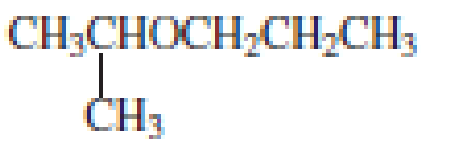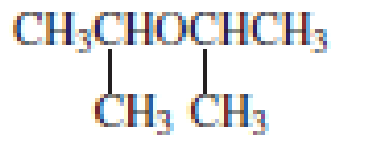
What are the common and systematic names of the following ethers?

- a. CH3CH2CH2CH2OCH2CH3


(a)
Interpretation:
The systematic name and the common name of the given ether have to be given.
Concept introduction:
IUPAC naming of Ether compounds:
An ether group consists of oxygen atom attached between two carbon chains. The shorter of two chains becomes the first part of the name with ‘ane’ changes to ‘oxy’ and the longer alkane becomes the suffix of the name of the ether.
When the Oxygen is not at the terminal position of main chain of alkane, then the shorter alkyl group and the ether group together are treated as a side chain and prefixed with its position of bonding on the main chain.
Common name for ether compounds:
- The name of the groups attached to the oxygen has to be given in alphabetical order followed by the word ether.
Explanation of Solution
The structure of the compound is given below:

From the structure of the compound, it is understood that the compound is an ether with three carbons in the parent chain. Hence, the parent chain will be propane. The numbering of the longest chain will be in such a way to get the carbon atom attached to the oxygen the possible lowest number.

The shorter alkyl group attached to the oxygen is the isopropyl group.
Therefore, systematic name of the compound is given below:

The common name of the compound can be identified by naming the alkyl groups attached to the oxygen followed by the word ether. In the given compound, one iso propyl group and one propyl group is attached to oxygen.
Therefore, common name of the compound is given below:
Propyl isopropyl ether
(b)
Interpretation:
The systematic name and the common name of the given ether has to be given.
Concept introduction:
IUPAC naming of Ether compounds:
An ether group consists of oxygen atom attached between two carbon chains. The shorter of two chains becomes the first part of the name with ‘ane’ changes to ‘oxy’ and the longer alkane becomes the suffix of the name of the ether.
When the Oxygen is not at the terminal position of main chain of alkane, then the shorter alkyl group and the ether group together are treated as a side chain and prefixed with its position of bonding on the main chain.
Common name for ether compounds:
- The name of the groups attached to the oxygen has to be given in alphabetical order followed by the word ether.
Explanation of Solution
The structure of the compound is given below:

From the structure of the compound, it is understood that the compound is an ether with four carbons in the parent chain. Thus the parent chain will be butane. The numbering of the longest chain will be in such a way to get the carbon atom attached to the oxygen the possible lowest number.

The shorter alkyl group attached to the oxygen that is in the first carbon is the ethyl group and therefore, the prefix will be “ethoxy”.
Therefore, the systematic name of the compound is given below:

The common name of the compound can be identified by naming the alkyl groups attached to the oxygen followed by the word ether. In the given compound, one ethyl group and one butyl group is attached to oxygen.
Therefore, common name of the compound is given below:
butyl ethyl ether.
(c)
Interpretation:
The systematic name and the common name of the given ether has to be given.
Concept introduction:
IUPAC naming of Ether compounds:
An ether group consists of oxygen atom attached between two carbon chains. The shorter of two chains becomes the first part of the name with ‘ane’ changes to ‘oxy’ and the longer alkane becomes the suffix of the name of the ether.
When the Oxygen is not at the terminal position of main chain of alkane, then the shorter alkyl group and the ether group together are treated as a side chain and prefixed with its position of bonding on the main chain.
Common name for ether compounds:
- The name of the groups attached to the oxygen has to be given in alphabetical order followed by the word ether.
Explanation of Solution
The structure of the compound is given below:

From the structure of the compound, it is understood that the compound is an ether with four carbons in the parent chain. Thus the parent chain will be butane. The numbering of the longest chain will be in such a way to get the carbon atom attached to the oxygen the possible lowest number.

The oxygen is attached to the second carbon.
The shorter alkyl group attached to the oxygen is the methyl group and therefore, the prefix will be “methoxy”.
Therefore, the systematic name of the compound is given below:

The common name of the compound can be identified by naming the alkyl groups attached to the oxygen followed by the word ether. In the given compound, one sec-butyl group and one methyl group is attached to oxygen.
Therefore, common name of the compound is given below:
Sec-butyl methyl ether.
(d)
Interpretation:
The systematic name and the common name of the given ether has to be given.
Concept introduction:
IUPAC naming of Ether compounds:
An ether group consists of oxygen atom attached between two carbon chains. The shorter of two chains becomes the first part of the name with ‘ane’ changes to ‘oxy’ and the longer alkane becomes the suffix of the name of the ether.
When the Oxygen is not at the terminal position of main chain of alkane, then the shorter alkyl group and the ether group together are treated as a side chain and prefixed with its position of bonding on the main chain.
Common name for ether compounds:
- The name of the groups attached to the oxygen has to be given in alphabetical order followed by the word ether.
Explanation of Solution
The structure of the compound is given below:

From the structure of the compound, it is understood that the compound is an ether with three carbons in the parent chain. Hence, the parent chain will be propane.

The shorter alkyl group attached to the oxygen that is in the second carbon is the isopropyl group and therefore, the prefix of the name will be “isopropoxy”.
Therefore, systematic name of the compound is given below:

The common name of the compound can be identified by naming the alkyl groups attached to the oxygen followed by the word ether. In the given compound, diisopropyl groups are attached to oxygen.
Therefore, common name of the compound is given below:
disopropyl ether.
Want to see more full solutions like this?
Chapter 9 Solutions
Essential Organic Chemistry, Global Edition
- When two solutions, one of 0.1 M KCl (I) and the other of 0.1 M MCl (II), are brought into contact by a membrane. The cation M cannot cross the membrane. At equilibrium, x moles of K+ will have passed from solution (I) to (II). To maintain the neutrality of the two solutions, x moles of Cl- will also have to pass from I to II. Explain this equality: (0.1 - x)/x = (0.1 + x)/(0.1 - x)arrow_forwardCalculate the variation in the potential of the Pt/MnO4-, Mn2+ pair with pH, indicating the value of the standard potential. Data: E0 = 1.12.arrow_forwardGiven the cell: Pt l H2(g) l dis X:KCl (sat) l Hg2Cl2(s) l Hg l Pt. Calculate the emf of the cell as a function of pH.arrow_forward
- The decimolar calomel electrode has a potential of 0.3335 V at 25°C compared to the standard hydrogen electrode. If the standard reduction potential of Hg22+ is 0.7973 V and the solubility product of Hg2Cl2 is 1.2x 10-18, find the activity of the chlorine ion at this electrode.Data: R = 8.314 J K-1 mol-1, F = 96485 C mol-1, T = 298.15 K.arrow_forward2. Add the following group of numbers using the correct number of significant figures for the answer. Show work to earn full credit such as rounding off the answer to the correct number of significant figures. Replace the question marks with the calculated answers or write the calculated answers near the question marks. 10916.345 37.40832 5.4043 3.94 + 0.0426 ? (7 significant figures)arrow_forwardThe emf at 25°C of the cell: Pt l H2(g) l dis X:KCl (sat) l Hg2Cl2(s) l Hg l Pt was 612 mV. When solution X was replaced by normal phosphate buffer solution with a pH of 6.86, the emf was 741 mV. Calculate the pH of solution X.arrow_forward
- Indicate how to calculate the potential E of the reaction Hg2Cl2(s) + 2e ⇄ 2Hg + 2Cl- as a function of the concentration of Cl- ions. Data: the solubility product of Hg2Cl2.arrow_forwardHow can Beer’s Law be used to determine the concentration in a selected food sample. Provide an in-depth discussion and examples of this.arrow_forwardb) H3C- H3C Me CH 3 I HN Me H+arrow_forward
- Using Luther's rule, determine the reference potentials of the electrodes corresponding to the low stability systems Co³+/Co and Cr²+/Cr from the data in the table. Electrodo ΕΝ Co²+/Co Co3+/Co²+ -0,28 +1,808 Cr³+ / Cr -0,508 Cr3+ / Cr²+ -0,41arrow_forwardThe molecule PYRIDINE, 6tt electrons and is there pore aromuntre and is Assigned the Following structure contenus Since aromatk moleculey undergo electrophilic allomatic substitution, Pyridine should undergo The Following reaction + HNO3 12504 a. write all of the possible Mononitration Products that could Result From this roaction Based upon the reaction the reaction mechanism determine which of these producty would be the major Product of the hegetionarrow_forwardUsing Benzene as starting materia Show how each of the Following molecules could Ve synthesked 9. CHI d. 10450 b 0 -50311 ८ City -5034 1-0-650 e NO2arrow_forward
 Chemistry for Today: General, Organic, and Bioche...ChemistryISBN:9781305960060Author:Spencer L. Seager, Michael R. Slabaugh, Maren S. HansenPublisher:Cengage Learning
Chemistry for Today: General, Organic, and Bioche...ChemistryISBN:9781305960060Author:Spencer L. Seager, Michael R. Slabaugh, Maren S. HansenPublisher:Cengage Learning Organic And Biological ChemistryChemistryISBN:9781305081079Author:STOKER, H. Stephen (howard Stephen)Publisher:Cengage Learning,
Organic And Biological ChemistryChemistryISBN:9781305081079Author:STOKER, H. Stephen (howard Stephen)Publisher:Cengage Learning, General, Organic, and Biological ChemistryChemistryISBN:9781285853918Author:H. Stephen StokerPublisher:Cengage Learning
General, Organic, and Biological ChemistryChemistryISBN:9781285853918Author:H. Stephen StokerPublisher:Cengage Learning


